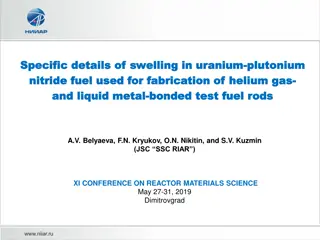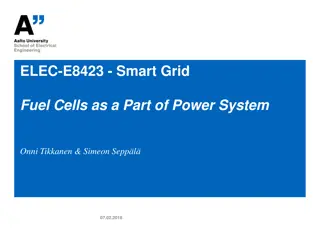Hydrogen as Future Fuel: Potential, Efficiency, and Production Methods
Hydrogen, the most abundant element in the universe, holds promise as a clean and renewable fuel for the future generation. Its high energy density, zero-emission characteristics, and various production methods like reforming fossil fuels and electrolysis of water make it a versatile and sustainable energy source. With the potential to revolutionize the energy sector and reduce dependence on traditional fuels, hydrogen stands as a beacon for a greener tomorrow.
Uploaded on Nov 12, 2024 | 0 Views
Download Presentation

Please find below an Image/Link to download the presentation.
The content on the website is provided AS IS for your information and personal use only. It may not be sold, licensed, or shared on other websites without obtaining consent from the author. Download presentation by click this link. If you encounter any issues during the download, it is possible that the publisher has removed the file from their server.
E N D
Presentation Transcript
Hydrogen As Fuel Presented By Shabir Ahmed Bhat (Assistant Professor Chemistry) Govt. Degree College(Boys) Anantnag
Hydrogen as a fuel hydrogen is the most abundant element in the universe Occurs mainly in bound form , water and hydrocarbons. Has the potential to become the fuel for the future generation Ability to harvest on renewable energy source Inexhaustibility and independence from foreign control
Some old saying in the context of hydrogen I believe that water will one day be employed as fuel, the hydrogen and oxygen which constitute it, used singly or together, will furnish an inexhaustible source of heat and light, of an intensity of which coal is not capable. I believe then that when the deposits of coal are exhausted, we shall heat and warm ourselves with water. Water will be the coal of the future." Jules Vernes (1870) "L le myst rieuse
Hydrogen economy drivers Hydrogen has more energy per unit mass than any other fuel Enables truly Zero emission vehicles. Potentially can be mass Produced and commercialized for passenger vehicles and air craft.
Calorific value comparison fuel Calorific value(Kj/Kg) carbon 34080 gasoline 47300 charcoal 29600 diesel 44800 methane 55,530 petrol 48000 wood 14400-17400 Alcohol Hydrogen 30,000 141790
Hydrogen production Reforming fossil fuels Electrolysis of water High temperature electrolysis Biological processes Very common in nature Experiment in laboratories
Steam reforming From any hydrocarbon Natural gas typically used water and hydrocarbon mixed at high temperature(700-1100 C) Steam reacts with methane CH4 + H2O CO + 3H2 Difficult to motivate investment in technology
Electrolysis of water Use electricity to split Water into H2and O2 2H2O 2H2+O2
Biological H2creation Nature has very simple method to split water Scientists are working to mimic these processes in the lab
Common requirements for hydrogen storage Weight and volume Cost Efficiency Safety Life cycle Environmental impact
Storage methods Physical storage:- Liquefaction , compression and physi-sorption Chemical storage:- metal hydrides complex hydrides
Challenges in storage For a given volume hydrogen contains a small amount of useable energy than other fuels such as natural gas and gasoline On weight basis, hydrogen has nearly three times the energy content of gasoline however on volume basis the situation is reversed
Compressed storage Involves pressurizing of gaseous sample at 150 bar Gravimetrically and volumetrically inefficient Most common storage system
Cryogenic Storage at low temperature(-253 C) Technologically challenging Boils at 20.15 K temperature Gravimetrically inefficient but volumetrically efficient Costly to condense
Chemical storage It involves storage as metal hydride Hydrogen adsorbed under low pressure gravimetrically and volumetrically efficient 15 times smaller in volume than 150bar high pressure tank Hydrogen released at elevated temperatures
Fuel cells fuel cells are electrochemical cells like batteries that convert chemical energy of a fuel directly and very efficiently into electricity with water and heat as its byproduct 2H2+ O2 2H2O+ heat and light Unlike a battery, fuel cell does not run down or require re-charging , it will produce energy as long as the fuel is supplied
Safety implications Hydrogen is highly inflammable gas High flame temperature Small molecular size promotes leaks and diffusion Negative joule thomson-cofficient, leaking gas warms and may spontaneously ignite
challenges Infra-structure : large scale manufacturing processes and support infra-structures , such as trained personal are not yet available The size and weight of current fuel cell system must be reduced to attain market acceptance , especially with automobiles























